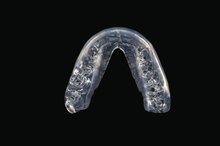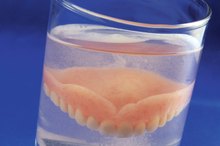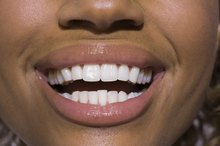How to Boil a Mouth Guard
A mouth guard is a piece of oral protective equipment, frequently used by athletes that participate in sports such as boxing, football, hockey or other sports where injury to the mouth and teeth may occur. People who grind their teeth while asleep may also wear a mouth guard. Made of resilient, rubbery plastic, a mouth guard fits around the teeth and follows the jawline of the wearer. This serves as a shock absorber around the teeth and gums and between the jaws. Mouth guards are custom-fit to the mouth of each person by softening them in boiling water.
Purchase a mouth guard that is the proper size for your mouth. Place the mouth guard in a small metal or glass bowl that will withstand boiling water. Prepare a bowl of cold water to immerse the mouth guard in later.
DIY Bite Guard
Learn More
Boil some water and fill the bowl with it to completely cover the mouth guard. Allow the mouth guard to sit for 20 to 30 seconds, until it softens.
Remove the mouth guard from the boiling water with the fork and dip it in cold water for three seconds. This allows the guard to cool just enough so you can fit it around your teeth and gums.
How to Boil your Mouth Guard
Learn More
Bite down on the mouth guard. Seal your lips and suck on the mouth guard hard for 45 seconds to one minute. During this time, press the guard against your teeth and gums with your tongue and lips while it cools. This will help form the device.
Open your mouth and check the guard for fit. If the mouth guard fits well, leave it in place for another two minutes, then remove the mouth guard.
If the impressions are not deep enough or the mouth guard is improperly aligned or loose, reheat the mouth guard and repeat steps 2 and 5.
When the shape of the mouth guard fits properly, immerse it in cold water to set the plastic permanently.
Warnings
If you wear orthodontic braces, do not suck on the mouth guard while fitting it to your mouth.
Related Articles
References
- American Dental Association (ADA). Xerostomia (Dry Mouth). Department of Scientific Information, ADA Science Institute. Updated July 9, 2019.
- Bartels C. Xerostomia. The Oral Cancer Foundation. Updated October 15, 2018
- Barnhart MK, Robinson RA, Simms VA, et al. Treatment toxicities and their impact on oral intake following non-surgical management for head and neck cancer: a 3-year longitudinal study. Support Care Cancer. 2018;26(7):2341-2351. doi:10.1007/s00520-018-4076-6
- Centers for Disease Control and Prevention. Candida Infections Of The Mouth, Throat, And Esophagus | Fungal Diseases | CDC. National Center for Emerging and Zoonotic Infectious Diseases (NCEZID), Division of Foodborne, Waterborne, and Environmental Diseases (DFWED). Updated November 13, 2019.
- V Sankar, N Rhodus, & the AAOM Web Writing Group. Xerostomia. The American Academy of Oral Medicine. Updated October 15, 2015.
- Rusthen S, Kristoffersen AK, Young A, Galtung HK, Petrovski BÉ, Palm Ø et al. Dysbiotic salivary microbiota in dry mouth and primary Sjögren's syndrome patients. PLoS One. 2019 Jun 18;14(6):e0218319. doi: 10.1371/journal.pone.0218319.
- V Sankar, N Rhodus & the AAOM Web Writing Group. Dry Mouth. The American Academy of Oral Medicine. Updated October 15, 2015.
- American Dental Association. Dry Mouth. Mouth Healthy. Updated January 2019.
- Men K, Geng H, Zhong H, Fan Y, Lin A, Xiao Y. A deep learning model for predicting xerostomia due to radiotherapy for head-and-neck squamous cell carcinoma in the RTOG 0522 clinical trial. Int J Radiat Oncol Biol Phys. 2019 Jun 12. pii: S0360-3016(19)30834-X. doi:10.1016/j.ijrobp.2019.06.009.
- National Institutes of Health. Dry Mouth. National Institute of Dental and Craniofacial Research. Updated January 2019.
Writer Bio
In Jacksonville, Fla., Frank Whittemore is a content strategist with over a decade of experience as a hospital corpsman in the U.S. Navy and a licensed paramedic. He has over 15 years experience writing for several Fortune 500 companies. Whittemore writes on topics in medicine, nature, science, technology, the arts, cuisine, travel and sports.









